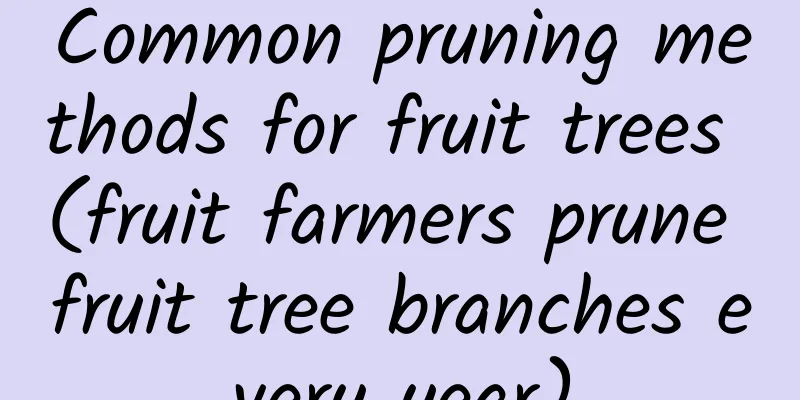Common pruning methods for fruit trees (fruit farmers prune fruit tree branches every year)

First of all, why do we prune branches and leaves when we plant fruit trees?As the crown of a fruit tree grows older and expands, too many branches and leaves will inevitably result in dense outside and hollow inside, premature aging of the tree, serious alternate bearing, and reduced fruit yield and quality. Therefore, we need to adopt some pruning techniques to reduce the occurrence of similar situations. 1. ShortenCutting off a part of the top and buds on the branch can concentrate nutrients, promote the buds at the cut to be dominant, and germinate into strong branches. The retraction of perennial branches is also a kind of pruning. Leaving nutrient branches below the cut so that they can extend again is called "reduction pruning"; not leaving leading branches below the cut is called "blocking", the purpose of which is to inhibit its growth, often forcing it to turn into branch groups. Generally speaking, the heavier the pruning, the stronger the local stimulation to the cut and the lower part, and the more severe the inhibition to the plant as a whole and even the root system. For newly planted fruits, do not prune too much, otherwise it is easy to cause slow fruiting. 2. ToppingThe main purpose is to remove the tender parts of the growing new shoots. The purpose is to inhibit the continued growth of the branch and promote the transfer of nutrients to the lower buds or their adjacent parts, which is conducive to flowering or fruiting. 3. ThinningThin out some branches and buds from the base. Because the nutrient area of the mother branch is reduced and some wounds are caused, the upper branches of the thinned branches will become weaker and the lower branches will become stronger. The overall effect of thinning branches varies depending on the type and amount of branches thinned. Thinning out weak branches, dense branches or overgrown branches can reduce useless consumption, increase effective photosynthetic area and benefit overall nutrition; but thinning out too many nutrient branches will reduce nutrient accumulation and weaken the root system and tree vigor. Operations such as bud removal and tip thinning during the growing season are also considered thinning and are more commonly used for evergreen fruit trees. 4. Slow downThe slow release is mainly based on the growth of fruit trees. The nutrient branches are not pruned and allowed to extend naturally, so as to utilize the weak apical buds to extend, gradually slowing down and weakening their apical dominance, thereby increasing the germination rate of the branch buds, promoting the growth of short branches, and inducing flowering. Slow release is usually combined with increasing the branch angle, and the effect is obvious when the branches grow nearly horizontally or obliquely downward. However, it is generally not used for overly vigorous upright branches. 5. Other pruning techniquesFor example, by means of scoring, ring cutting, twisting the tips or softening the branches, the organs or part of the conducting tissue can be injured, so that the direction or speed of nutrient delivery can be temporarily changed. This is also effective in alleviating excessive growth, promoting flowering and increasing fruit setting. The application of the above-mentioned pruning methods should be adapted to the conditions of the tree and the location, based on the growth and fruiting characteristics of different tree species and varieties, as well as factors such as rootstock, tree age, and tree vigor, while also taking into account the characteristics of natural conditions and the level of cultivation management. At the same time, we need to pay attention to the comprehensive application of various pruning methods and the coordination between winter pruning and summer pruning. |
Recommend
How to grow plum blossoms
1. Breeding environment (1) Soil: Mainly require ...
Do hydrangeas like sunlight? Do they need sunlight?
Introduction to Hydrangea There are many common v...
Ranunculus becomes a small potted plant
Ranunculus bonsai preparation materials Sword-sha...
Cultivation methods and precautions of Pittosporum
1. Lighting Their demand for light is relatively ...
Daphne koreana cutting time
1. Cutting time There are many options for the ti...
How often should indoor flowers and plants be watered?
1. How many days should I water? 1. Variety: How ...
What vegetables are suitable for planting in September? What vegetable varieties are suitable for planting in September?
The weather gradually becomes cooler in September...
What should I do if the leaves of the money tree turn yellow?
As a common household ornamental plant, the money...
How to grow yellow-skinned ebony succulent
Yellow-skinned ebony is a succulent plant with th...
Can ginseng be grown in the south?
Can ginseng be grown in the south? Ginseng cannot...
How long is the growth cycle of the nameko mushroom?
Nameko mushroom growth cycle The growth period of...
Can pineapple leaves be grown hydroponically?
1. Hydroponics Pineapple leaves can be grown hydr...
What fertilizer is best for sunflower?
Oil sunflower fertilization time Generally speaki...
Why is Clivia a famous flower?
1. Reasons Clivia is originally an African flower...
Don’t throw away the old soil after repotting. Add some of this, it is more fertile than nutrient soil!
Soil disinfection methods 1. First of all, the ol...









